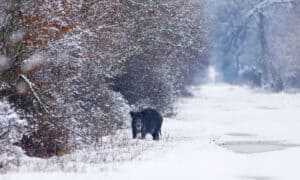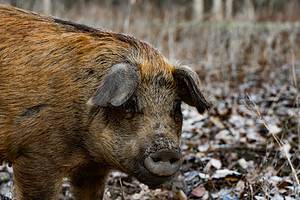Wild hogs, also known as feral hogs, wild pigs, wild boars, or razorbacks, are one of the most destructive invasive species in the United States. Forty states, including Hawaii, have populations of wild hogs. They add up to as many as nine million, countrywide. They mainly reside in the southern part of the country but range all the way north to Canada. And that includes Michigan. So, what’s the problem? Well, even a small number of feral hogs can do tremendous damage to the natural environment, livestock, and property. They’re also aggressive and territorial, attack people and animals, and can spread up to 34 different diseases. This article will tell you all you need to know about wild hogs in Michigan.
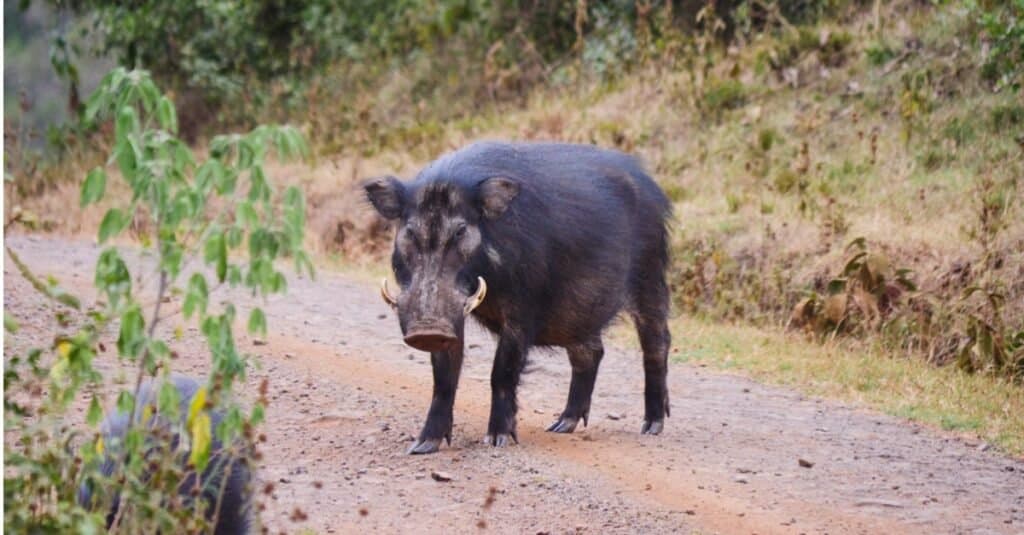
Feral hogs do millions of dollars in damage to farms and other private property.
©iStock.com/chingkai huang
What is the Origin of the Feral Pig Population?
Pigs are not an indigenous species in North America. They were brought to the continent originally by Christopher Columbus. He released them on Caribbean islands to multiply as a food source for future explorers. This practice continued under later explorers, and when colonists started farms, some pigs escaped and joined the wild herds. In modern times, some people have deliberately introduced pigs into the wild for hunting purposes. In other cases, game reserves have kept them improperly contained so that they escaped and formed feral herds.
Today they number approximately nine million in 40 of the 50 states as well as several Canadian provinces. The largest populations are in Texas, with three million, Oklahoma, with 1.5 million, and Louisiana with 750,000. What about Michigan? No one knows how many there are, but they have been spotted in 70 of the state’s 83 counties. Some experts estimate there may be 5,000 wild hogs in Michigan. Some of these may have escaped from game reserves before 2012.
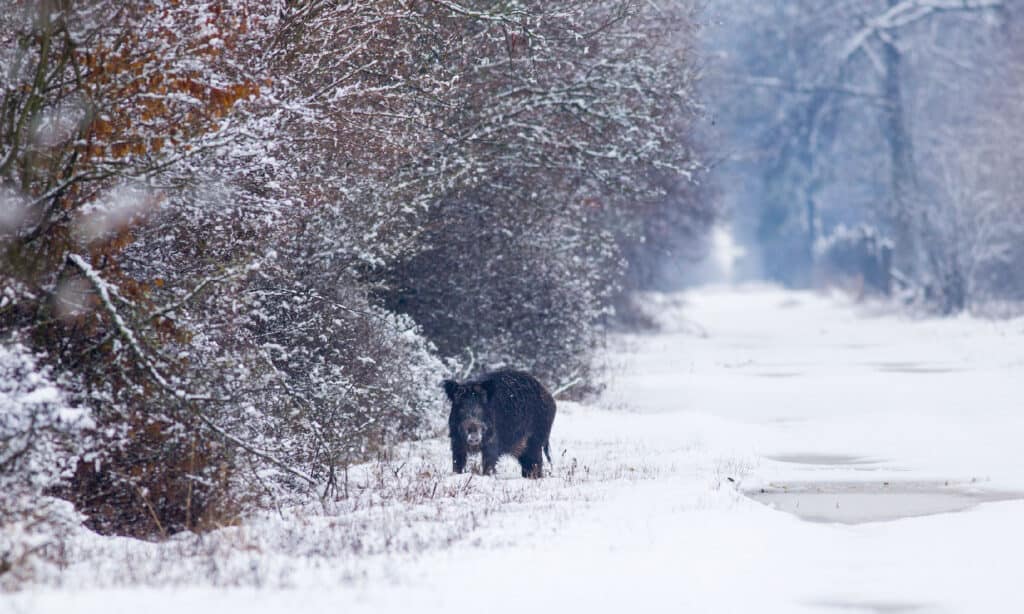
Wild pigs were originally released in the tropics of the Caribbean and the southern part of the U.S.
©iStock.com/Jevtic
What’s the Problem With Feral Pigs?
Pigs don’t deserve to be demonized. They’re a crucial food source and they’re highly intelligent. Some people keep them as pets and fiercely defend them from their detractors. However, feral pigs are a dangerous, expensive, and environmentally destructive invasive species. These are some of the reasons so many people are concerned about wild hogs in Michigan and other states:
Aggressive and territorial
Feral pigs are aggressive and territorial. This is particularly true when they are competing for mates or sense a threat to their young. Male pigs, known as boars, have tusks that are long, sharp, and curved. They are perfect for goring their enemies with aggressive head thrusts. In fights over females or territories, it’s not unusual for males to be killed by bigger, stronger, or faster rivals. They are omnivores, often eating small mammals and birds. They are even known to kill lambs and calves for food. These hogs are also a threat to pets, children, and adults who get too close to them.
Disease Carriers
Wild hogs are known to carry up to 34 different diseases, some of them highly infectious and deadly to animals and people. These can be spread by a bite, by handling the carcass, or by eating the pork without taking careful precautions. Pig farmers are particularly fearful feral pigs could bring back swine flu. This respiratory disease was eradicated in 1978 only after decades of intense, concentrated effort. It was hard enough to eliminate the disease when it was localized on farms that could be isolated. If this disease were to spread freely among an uncontained population, it would be nearly impossible to contain.
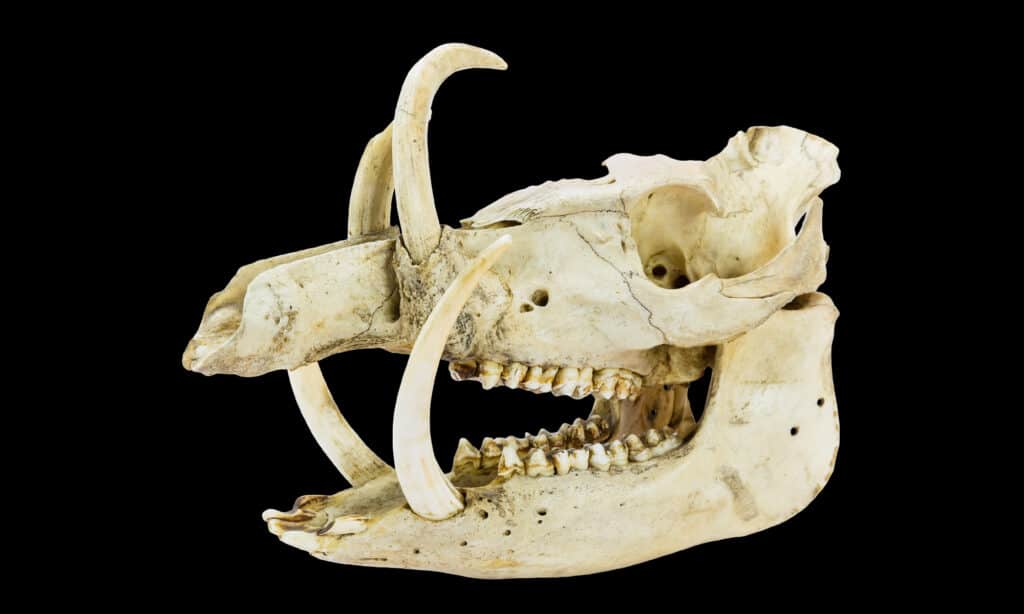
This looks like a prehistoric animal, but it is actually the skull of a modern
wild boar
.
©iStock.com/Ben-Schonewille
Damage to Farms and Homes
The U.S. Department of Agriculture has estimated that feral hogs do about $1.5 billion in damage every year to farms in the United States. This includes eating just about any crop farmers grow, including corn, soybeans, pumpkins, watermelons, carrots, spinach, you name it. They love to root around in the ground looking for bulbs, grubs, bird eggs, or ground-burrowing mammals. They consume all of these without discrimination. Even a single pig can overturn a truly enormous area of soil. A whole herd can decimate a potato field or expensive landscaping and turf at a golf course or public park. Their rooting creates ruts that solidify in the heat and become hazards for livestock to trip over. They also make it difficult to drive tractors and other farm equipment over the area.
Feral pigs carry parasites that make their skin itch, so they’re always looking for things to scratch themselves on. When they do this to trees, it wears the bark off and exposes the interior to fungi and disease. It’s also one of the ways they break down fences. Keeping them out requires a high fence, buried several feet underground at the bottom, and ideally electrified. These preventative measures are yet another expense they inflict on property owners. Finally, pigs are well-known for their love of wallowing in mud on the banks of streams and ponds. A herd stirs up a lot of mud which, mixed with their urine and feces, makes the water undrinkable. Other species, including fish and aquatic life, suffer.
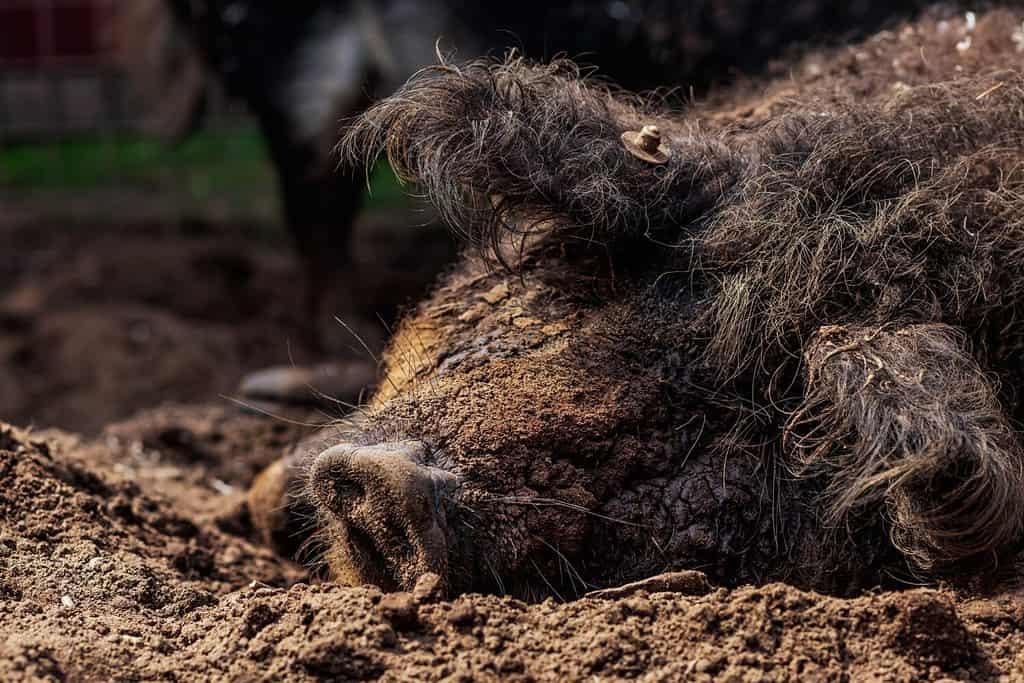
Wild pigs love wallowing in the mud, and they dig up the ground and make mud everywhere they go.
©Salah Ait Mokhtar/Shutterstock.com
Ecological Damage
Something that is harder to measure in dollars but may be the most damaging thing of all about wild pigs is the destruction they wreak on natural ecosystems. In fact, studies show that forests infested with wild pigs have 25% lower biodiversity than those that are free of pigs. Why is that? The pigs’ eating, rooting, and wallowing activities kill large numbers of smaller animals and birds, overturn the soil and kill plants other species are dependent on for food, and contaminate the water supply. All of this drives off those animals that can get out of their way to less dangerous places and leaves the forest as a pig pen. Larger species leave as they find less prey in the area.
Moreover, the forest itself can be in danger. Large numbers of pigs scratching against trees can strip their bark and kill them, and the trampling and rooting of the pigs prevent new saplings from taking root and replacing trees that die. All this destruction makes even the most tender-hearted animal lovers take pause and realize something needs to be done to control the feral pig population. But what?

Wild boars eat plants and animals without discrimination, which may be why they carry so many diseases.
©iStock.com/JMrocek
Anti-Pig Strategies
Information
Information is one of the most important resources for wildlife authorities trying to control wild hogs in Michigan and other parts of the United States. Gathering hunter and citizen reports, examining tracks and environmental damage, tagging and tracking pigs, using trail cameras, and tracking them with dogs and by air are all some of the ways authorities are learning more all the time about feral pigs’ movements and habits. Localities and neighboring states often share information as feral populations cross administrative borders.
Poisoning or Contraceptives
One effective way to deal with feral hogs is to put out hog feed laced with poison or contraceptives. This has to be done using specially-designed feeders that pigs can access but that are difficult for other animals to use. This does introduce a deadly chemical into the ecosystem that could affect other creatures that feed on the carcass of the dead animals. There is also a contraceptive that causes male hogs to be infertile for 30 days. This temporary solution has to be repeated every month, which creates an ongoing expense for the landowner or the state.
Extermination
Many states, including Michigan, try to reduce or eliminate feral pig populations through hunting and trapping. Sport hunting is one of the few ways wild boars can actually bring any economic benefit to an area, especially if it is well-established enough to attract out-of-state hunters and provide services and amenities for them. One problem with hunting is that it can drive herds away into other areas that may be more environmentally at risk, closer to populated areas, or into jurisdictions that don’t allow hunting. Some experts consider trapping a better solution as traps can work 24/7 and traps can multiply the number of pigs that can be taken out by one person. Traps need to be monitored frequently, though, and can harm species other than feral pigs.
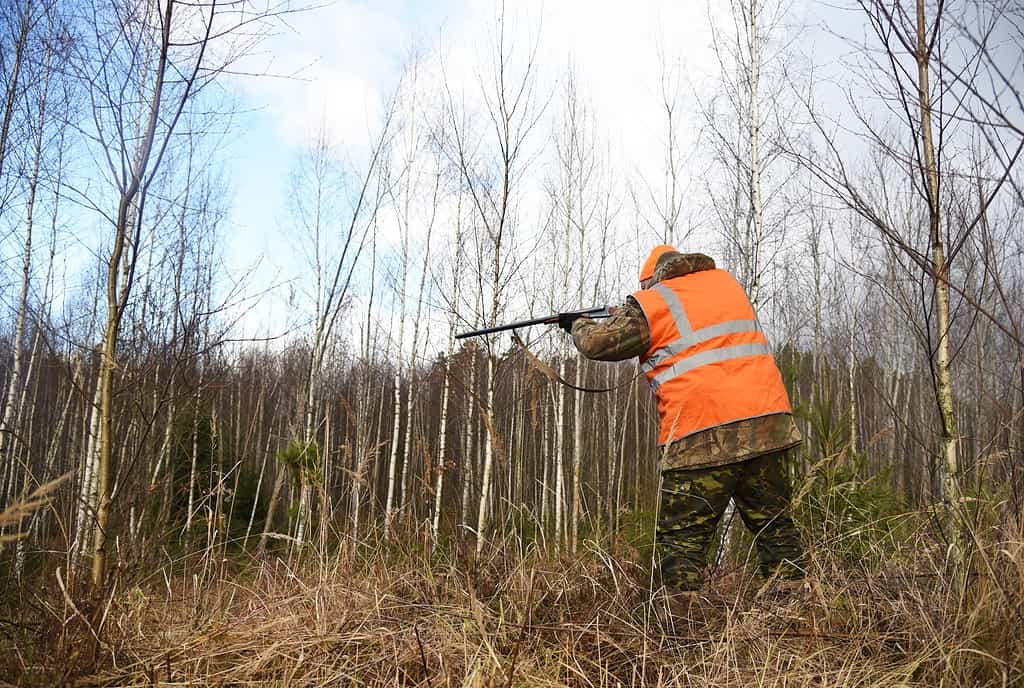
This hunter prepares to fire on a
wild boar
.
©Maksim Safaniuk/Shutterstock.com
Can You Hunt Wild Hogs in Michigan?
Hunting wild hogs in Michigan is legal all year round during regular hunting hours. Hunters should familiarize themselves with any general hunting regulations that may be in place at different times of the year. Killing wild hogs on private property is unrestricted as long as you have the permission of the landowner. On public property, you’ll need a license to carry a concealed pistol and a valid hunting license.
Hunters are not allowed to use weapons in areas where prohibited by local ordinances. Law enforcement or wildlife authorities should be notified when a wild pig is killed as they may want to collect DNA samples and other data to help them monitor the invasive population. Hunters should use careful sanitary practices when handling wild boar and preparing the meat, and make sure it is thoroughly cooked to an internal temperature of 145°F to kill pathogens. If you would like to hunt wild boar in another state, check out this site with a list of the current hunting status of feral hogs in each state.
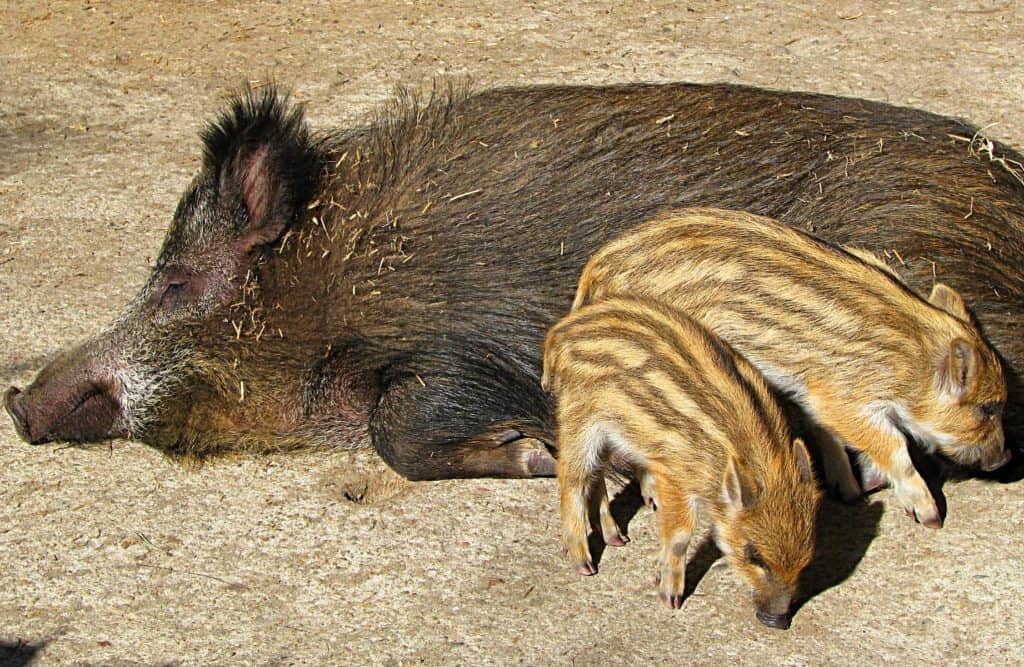
Contraceptive-laced pig feed can reduce feral hogs’ ability to reproduce.
©Jarosław Pocztarski / CC BY 2.0 – License
What’s the Solution?
Feral hogs in Michigan and around the country are a serious problem that was created by people and will require people to solve it. In many of the areas where they roam, near farms and on the outskirts of sparsely populated areas, there just are no other apex predators to take them down besides humans. And honestly, controlling the spread of pigs with large numbers of bears, mountain lions, and wolves would put us in a worse situation than we’re already in! Most likely, this is not a problem that will be completely eliminated, but with a combination of strategies customized for different localities, the damage from feral hogs can be minimized and people’s lives and property can be safeguarded.
The photo featured at the top of this post is © iStock.com/ViktorCap
Thank you for reading! Have some feedback for us? Contact the AZ Animals editorial team.




